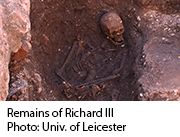- Navigating Your Midlife Crisis: Embracing New Possibilities
- City Raccoons Showing Signs of Domestication
- Mapping the Exposome: Science Broadens Focus to Environmental Disease Triggers
- One Week Less on Social Media Linked to Better Mental Health
- Your Brain Changes in Stages as You Age, Study Finds
- Some Suicide Victims Show No Typical Warning Signs, Study Finds
- ByHeart Formula Faces Lawsuits After Babies Sickened With Botulism
- Switch to Vegan Diet Could Cut Your Greenhouse Gas Emissions in Half
- Regular Bedtime Does Wonders for Blood Pressure
- Dining Alone Could Mean Worse Nutrition for Seniors
Richard III Likely Had Blond Hair, Blue Eyes, Study Shows


England’s King Richard III most likely had blue eyes and blond hair, at least when he was a child, according to genetic tests that also confirm it was his remains found beneath a parking lot in Leicester, England.
Richard III — immortalized in the Shakespeare play that bears his name — was killed in the Battle of Bosworth Field in 1485 and was the last English king to die in battle. The location of his remains had remained a mystery for centuries until his skeleton was discovered in 2012.
According to researchers, the newly released results of genetic tests provide greater than 99.99 percent proof that the skeleton is that of King Richard III.
“The evidence is overwhelming that these are indeed the remains of King Richard III, thereby closing an over 500-year-old missing person’s case,” Dr. Turi King, of the University of Leicester’s department of genetics, said in a university news release.
The test results also show a match between the king and two living descendants, the researchers reported online Dec. 2 in Nature Communications.
DNA is even helping historians get closer to what the deposed monarch looked like. According to Turi’s team, the genetic evidence suggests that the depiction of the king that most closely matches his actual eye and hair color — blue and blond, respectively — is one of the earliest portraits of him that still exists. The “Arched-Frame Portrait” is in the Society of Antiquaries in London.
The researchers plan to go on to sequence Richard III”s complete genome to learn more about him.
One other finding: The paternal line of DNA was “broken” in one or more points over the generations, the researchers said. That means that at points over the past centuries, the paternity of certain descendants was probably different than what was officially recorded.
This “does pose interesting speculative questions over [royal] succession as a result,” Kevin Schurer, a professor of English Local History at the university, said in the news release.
More information
The American Society of Human Genetics has more about genetics.
Source: HealthDay
Copyright © 2025 HealthDay. All rights reserved.










